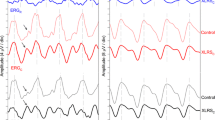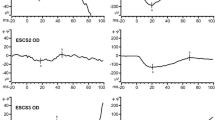Abstract
Spectral sensitivity functions and the transient decrease of sensitivity to short wavelengths after the offset of yellow light (transient tritanopia) were measured by increment threshold techniques in patients suffering from hereditary macular degenerations. Color vision defects were determined by arrangement tests and the anomaloscope.
Central areolar choroidal dystrophy was found to produce a mild protan defect and to reduce foveal spectral sensitivity throughout the visible spectrum by a factor of 100; it also abolishes transient tritanopia. Electroretinogram (ERG) was normal, electrooculogram (EOG) subnormal.
Stargardt's disease, despite numerous fluorescent macular spots, does not abolish transient tritanopia nor does it reduce spectral sensitivity, although scotopic matches were performed on the Nagel anomaloscope. Only in severe, advanced cases was transient tritanopia reduced and spectral sensitivity found to follow the absorption spectrum of rods. Routine ERGs and EOGs were normal.
Vitelliform macular degeneration, despite the ophthalmoscopically pronounced dystrophic macula, produced only very small changes in spectral sensitivity and transient tritanopia, although a widened matching range on the Nagel anomaloscope and electrophysiological abnormalities were found. Apparently damage of the retinal circuit which connects long and short wavelength-sensitive cones, caused by hereditary conditions, is different from that caused by retinotoxic drugs.
Similar content being viewed by others
References
Baier, M and Zrenner, E (1984) Rechnergestützte Verfahren zur Klassifizierung von angeborenen und erworbenen Farbensinnstörungen. EDP in Medicine and Biology 15: 77–83
Ehinger, B (1982) Neurotransmitters systems in the retina. Retina 2: 305–321
Gouras, P (1968) Identification of cone mechanisms in monkey ganglion cells. J Physiol 199: 533–547
King-Smith, PE and Carden, D (1976) Luminance and opponent-color contributions to visual detection and adaptation and to temporal and spatial integration. J Optom Soc Am 66: 709–718
Mollon, JD and Polden, DG (1979) An anomaly in the response of the eye to light of short wavelengths. Philos Trans R Soc Lond (Biol) 278: 207–240
Stiles, WS (1949) Increment thresholds and the mechanisms of colour vision. Doc Ophthalmol 3: 138–163
Valeton, JM and Norren van, D (1979) Retinal site of transient tritanopia. Nature 280: 488–490
Wyszecki, G and Stiles, WS (1967) Color science: Concepts and methods, quantitative data and formulas. New York, John Wiley and Sons
Zrenner, E (1977a) Influence of stimulus duration and area on the spectral luminosity function as determined by sensory and VECP measurements. Doc Ophthalmol Proc Series 13: 21–30
Zrenner, E (1977b) Color opponency in visually evoked potentials (VECP). Invest Ophthalmol Vis Sci (ARVO Suppl) 16: 157
Zrenner, E (1982) Interactions between spectrally different cone mechanisms: On the clinical applicability of psychophysical and electrophysiological tests. Doc Ophthalmol Proc Series 1982; 31: 287–295
Zrenner, E(1983a) Neurophysiological aspects of colour vision mechanisms in the primate retina: Comparative studies on simian retinal ganglion cells and the human visual system. In: Studies of Brain Function, Vol. 9, Barlow, HB, Bullock, H, Florey, E, et al., eds. Berlin, Springer Verlag, 1–213
Zrenner, E (1983b) Electrophysiological characteristics of the blue-sensitive mechanism: Test of a model of cone interaction under physiological and pathological conditions. Doc Ophthalmol Proc Series 33: 103–125
Zrenner, E and Gouras, P (1981) Characteristics of the blue-sensitive cone mechanism in primate retinal ganglion cells. Vision Res 21: 1605–1609
Zrenner, E and Krüger, C-J (1981) Ethambutol mainly affects the function of red-green-opponent neurons. Doc. Ophthalmol Proc Series 27: 13–25
Zrenner, E, Nowicki, J, Pillmann, G (1984) Conditions affecting interactions between spectrally different cone mechanisms. Invest Ophthalmol Vis Sci (ARVO Suppl) 25: 146
Author information
Authors and Affiliations
Rights and permissions
About this article
Cite this article
Zrenner, E., Nowicki, J. & Adamczyk, R. Cone function and cone interaction in hereditary degenerations of the central retina. Doc Ophthalmol 62, 5–12 (1986). https://doi.org/10.1007/BF00140540
Issue Date:
DOI: https://doi.org/10.1007/BF00140540




